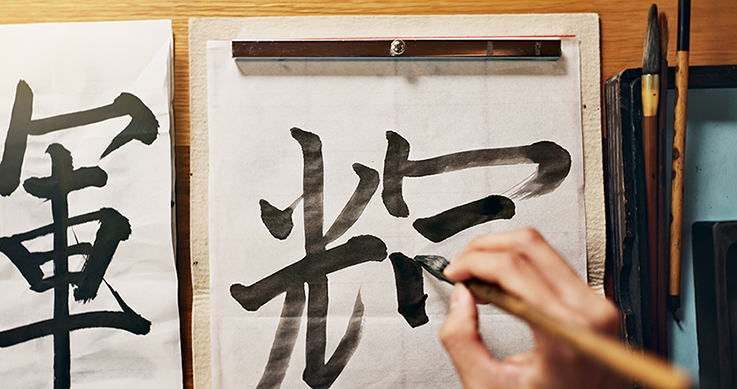Japan is a country known for its rich cultural traditions, from the mesmerising tea ceremonies to the elegance of kimonos. Among these traditions, Japanese calligraphy, or Shodō, stands out as an art form that beautifully encapsulates the essence of Japanese aesthetics and philosophy. Shodō, which translates to “the way of writing,” is more than just a method of writing characters; it is an expressive art that conveys the writer’s spirit and emotions. For tourists visiting Japan, exploring the world of Shodō offers a profound insight into Japanese culture and a chance to experience the meditative practice of this ancient art.

The History and Evolution of Shodō
Shodō has a history that spans over a thousand years, with its origins deeply rooted in Chinese calligraphy. Calligraphy was introduced to Japan from China around the 5th century along with the Chinese writing system. Initially, Japanese calligraphy closely followed Chinese styles and techniques, but over time, it evolved to reflect Japanese aesthetics and sensibilities.
During the Heian period (794-1185), Shodō began to develop its distinct Japanese character. The kana syllabary, created during this period, allowed for more fluid and expressive writing styles. This period also saw the rise of the “Three Great Brushes,” or the “Sanpitsu,” referring to the eminent calligraphers of the time whose works significantly influenced the art of Shodō.
The Edo period (1603-1868) marked a flourishing of Japanese arts and culture, including calligraphy. The practice of Shodō became more widespread, with samurai, courtiers, and even commoners studying the art. Calligraphy was not only a means of communication but also a reflection of one’s education and refinement.
The Philosophy and Techniques of Shodō
Shodō is deeply intertwined with Zen Buddhism, emphasising simplicity, mindfulness, and the expression of the artist’s inner state. The act of writing in Shodō is a meditative process where the calligrapher must focus entirely on the brushstrokes, achieving a state of “mushin” or “no-mind,” akin to a form of meditation.
The tools used in Shodō are simple yet essential. They include:
Fude (Brush): The calligraphy brush is typically made of bamboo with bristles from animals like horse, sheep, or weasel. Brushes come in various sizes and types, each suited for different styles and effects.
Sumi (Ink Stick): Traditional ink sticks are made from soot and animal glue, ground on an ink stone and mixed with water to create liquid ink. The process of grinding the ink is an integral part of the meditative practice.
Suzuri (Ink Stone): The ink stone is used to grind the ink stick and mix it with water. The quality of the ink stone can significantly affect the final outcome of the calligraphy.
Washi (Japanese Paper): Washi, or Japanese paper, is prized for its texture and absorbency. It allows for smooth and controlled brushstrokes, essential for creating beautiful calligraphy.
Shodō styles can range from the highly structured and precise “kaisho” (block style) to the more fluid and cursive “sōsho” (grass style). Each style requires a different technique and level of skill, but all share the same fundamental principles of balance, harmony, and expressive beauty.
Experiencing Shodō in Japan
For tourists, engaging with Shodō offers a unique and enriching cultural experience. Various opportunities exist for visitors to learn and appreciate this art form:
Calligraphy Workshops:
Many cultural centers, schools, and studios offer calligraphy workshops for beginners and enthusiasts. These workshops typically start with an introduction to the history and philosophy of Shodō, followed by hands-on practice. Participants learn the basics of brush handling, ink preparation, and creating simple characters. Experienced instructors guide students through the process, providing insight into the nuances of each brushstroke.
Exhibitions and Museums:
Museums and galleries across Japan often feature exhibitions dedicated to calligraphy. These exhibitions showcase works by famous calligraphers, both historical and contemporary, allowing visitors to appreciate the diversity and evolution of Shodō. The Tokyo National Museum and the Kyoto National Museum are notable places where visitors can see exquisite examples of Japanese calligraphy.
Visiting Temples and Shrines:
Many temples and shrines in Japan have beautiful calligraphy displayed on hanging scrolls and plaques. The serene environment of these sacred sites provides an ideal setting to reflect on the spiritual aspects of Shodō. Some temples also offer calligraphy classes as part of their cultural programs, combining the practice of Shodō with Zen meditation.
Purchasing Calligraphy Art:
For those who wish to bring a piece of this beautiful art form home, numerous shops and galleries sell calligraphy artworks. These can range from traditional scrolls and framed pieces to modern interpretations of the art. Purchasing a piece of calligraphy not only supports local artists but also serves as a meaningful souvenir of one’s journey through Japanese culture.
Conclusion
Japanese calligraphy, or Shodō, is a profound and beautiful expression of Japanese culture. Its history, philosophy, and techniques offer a window into the soul of Japan, blending artistic skill with spiritual depth. For tourists visiting Japan, engaging with Shodō is more than just an activity; it is an immersive experience that connects them to the country’s cultural heritage and the timeless beauty of written characters. Whether through workshops, exhibitions, or simply appreciating the elegance of calligraphy in temples and galleries, exploring the world of Shodō is a journey into the art of beautiful writing and the essence of Japanese aesthetics.










